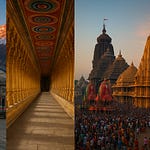Nestled quietly in the lush, verdant surroundings of Neelgunda village in Karnataka’s Davangere district, the magnificent Bheemeshwara Temple (also known as Bhimeshvara Temple) is a testimony to the rich cultural and architectural heritage of India. Built over a millennium ago, this temple remains relatively unknown, maintaining its mystical charm and tranquil ambience.
Historical Origins and Architecture
Dating back to over 1000 years, the Bheemeshwara Temple exemplifies the grandeur of the Western Chalukya dynasty, renowned for their distinct architectural style. The temple's unique chatuskuta design, comprising four sanctums, is noteworthy, with the main shrine facing west and featuring intricately carved details, beautiful lathe-turned pillars, and stunning ceilings.
The temple's primary sanctum is adorned by a meticulously crafted shikhara (tower), with ornate carvings depicting various Hindu mythological scenes. Its walls display intricate sculptures and elegant stone carvings, telling tales from ancient scriptures and epics, prominently featuring Shiva and related mythologies.
Tucked away in the serene village of Neelgunda in Karnataka’s Davangere district, the Bheemeshwara Temple (also known as Bhimeshvara Temple) stands as a timeless testament to India’s rich spiritual and architectural heritage. This temple, believed to be over 1000 years old, continues to captivate pilgrims and history enthusiasts alike with its divine aura, mesmerizing architecture, and deep-rooted legends. Despite its age, Bheemeshwara Temple remains relatively unknown, making it a truly hidden gem waiting to be explored.
The origins of the Bheemeshwara Temple trace back to the Western Chalukya dynasty, which ruled over parts of South India between the 10th and 12th centuries CE. The temple is believed to have been built between the late 10th and early 11th centuries, during an era marked by the flourishing of art, architecture, and religious devotion.
The temple’s historical significance is tied to ancient folklore, with many believing that it has existed since the time of the Mahabharata. This sacred site has witnessed centuries of devotion, with countless pilgrims visiting to seek blessings and inner peace. Its long-standing presence is a reflection of India’s enduring spiritual and cultural traditions.
Architectural Marvel
Bheemeshwara Temple is a stunning example of the Vesara style of architecture, which blends elements of the Dravidian and Nagara styles. What makes this temple unique is its chatuskuta (four-shrine) layout, a rare design found in only a few temples in India.
Key Architectural Highlights:
Chatuskuta Design: The temple consists of four sanctums, each dedicated to different deities, with the main sanctum facing west.
Intricate Carvings: The outer walls are adorned with detailed sculptures and relief carvings, depicting various Hindu mythological stories and deities, predominantly focusing on Lord Shiva.
Lathe-Turned Pillars: The temple’s interior features beautifully polished, lathe-turned pillars that support the sabhamantapa (main hall).
Shikhara (Temple Tower): The main shrine is crowned with a tiered Vesara-style shikhara, embellished with miniature decorative towers and pilasters.
Ornate Doorways: The temple doorways are adorned with intricate depictions of Shiva in different forms, including Nataraja (the cosmic dancer) and Maheshvara (the great lord).
The stunning craftsmanship of the temple showcases the architectural excellence of the Western Chalukyan era, making it a must-visit for history and art lovers.
Rituals and Devotional Practices
Bheemeshwara Temple remains an active place of worship where devotees regularly perform prayers and rituals. Special ceremonies take place on Maha Shivaratri, the grand annual festival dedicated to Lord Shiva, when the temple resonates with divine energy and spiritual fervor.
Key Rituals and Devotional Activities:
Daily Pujas: Regular offerings and prayers to Lord Shiva.
Maha Shivaratri Celebrations: Grand festivities featuring night-long vigils, bhajans, and abhisheka (ritual bathing of the Shiva Linga).
Meditation and Spiritual Practices: Many visitors come to the temple to meditate in its tranquil surroundings, seeking spiritual solace.
The temple’s serene atmosphere makes it an ideal place for those looking to reconnect with their spiritual roots and experience peace.
Mysteries and Legends
Like many ancient temples in India, Bheemeshwara Temple is shrouded in intriguing legends. Local folklore links the temple to the Mahabharata, claiming that Bhima, one of the Pandava brothers, established the Shiva Linga at this site during their exile. This belief adds a layer of mysticism to the temple, drawing spiritual seekers eager to experience its divine history.
Another belief suggests that the temple was built by local kings and later expanded by the Western Chalukyas, who were great patrons of Shaivism (worship of Lord Shiva). The presence of intricate Shaivite carvings and inscriptions supports this claim, indicating that the temple was a significant religious center for centuries.
Devotees and Pilgrimage
The temple attracts devotees from across Karnataka and neighboring states, offering them a peaceful retreat for prayer and contemplation. Unlike many overcrowded pilgrimage sites, Bheemeshwara Temple retains its untouched beauty, providing a deeply personal spiritual experience.
Experiences for Devotees:
Seeking Blessings: Devotees offer prayers to Lord Shiva for prosperity and well-being.
Pilgrimage Visits: Many travelers include this temple in their spiritual journeys, visiting along with other historical temples in Karnataka.
Meditative Retreat: The temple’s calm and secluded location makes it a perfect spot for silent meditation and introspection.
What to Do at Bheemeshwara Temple
Visitors to Bheemeshwara Temple can engage in several enriching activities:
Explore the Architectural Beauty: Witness the intricate sculptures, temple carvings, and historic inscriptions.
Participate in Rituals: Join the daily pujas or attend special ceremonies.
Photography: Capture stunning visuals of the temple’s historical grandeur and natural surroundings.
Spiritual Reflection: Spend time in meditation, experiencing the temple’s peaceful energy.
Local Cultural Interaction: Speak with locals and temple priests to learn more about its historical and religious significance.
Travel and Accessibility
Reaching the Bheemeshwara Temple is a rewarding journey through scenic landscapes and rural Karnataka’s beauty.
How to Travel to Bheemeshwara Temple:
By Road: The temple is approximately 32 km from Harihar, with well-maintained roads making for a pleasant drive. Private taxis, rental cars, or even local buses can be used.
By Rail: The nearest railway station is Harihar Railway Station, well-connected to major cities like Bangalore, Hubli, and Mysore. From there, local transport is available.
By Air: The nearest airport is Hubli Airport, about 140 km away. From the airport, visitors can take a taxi or drive to Neelgunda.
Preservation and Visitor Guidelines
As a protected heritage site under the Archaeological Survey of India, the temple is well-maintained, but visitors must follow guidelines to ensure its preservation.
Important Visitor Guidelines:
Respect the Sanctity: Avoid loud conversations and maintain silence in the temple premises.
No Littering: Keep the area clean and avoid damaging the heritage structures.
Follow Dress Code: Modest attire is recommended when visiting religious sites.
Photography Restrictions: Some areas may have restrictions on photography—check with temple authorities before taking pictures.
Bheemeshwara Temple is not just a place of worship but a living heritage site that embodies Karnataka’s ancient past, architectural brilliance, and spiritual significance. Whether you are a devotee seeking divine blessings, a history lover exploring ancient architecture, or a traveler looking for serene experiences, this hidden gem promises an unforgettable journey into India’s spiritual heartland.
Om Namah Shivaya 🙏










